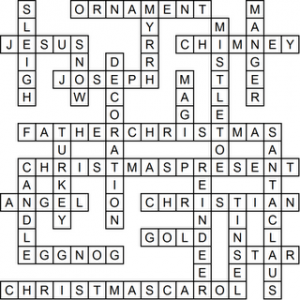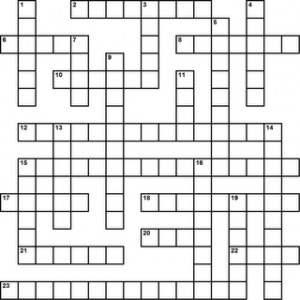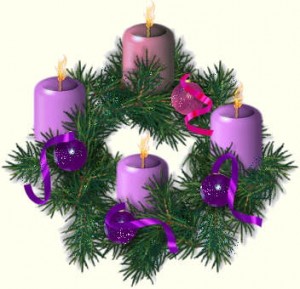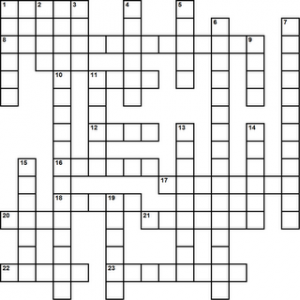Blog Archives
Christmas Crossword II (Solution)
Christmas Crossword II
Across
2. an object that adds beauty to something; a decoration
6. the name of Christ, the central figure of Christianity (believed by Christians to be the Son of God)
8. a vertical pipe in a house that allows smoke and gases to escape from a fireplace (Father Christmas traditionally enters a house through its chimney)
10. the husband of Mary (the mother of Jesus)
12. an imaginary being who brings presents for children on the night before Christmas Day (also known as Santa Claus) – traditionally an old man with a red suit and white beard
15. a gift or present given at Christmas
17. a spiritual being acting as a messenger of God (usually shown as a human being with wings)
18. a person who believes in Christianity
20. a yellow precious metal, one of the gifts that the three wise men gave to Jesus
21. a traditional Christmas drink made of alcohol with beaten eggs and milk
22. a bright point in the night sky which is a large, distant incandescent body like the sun
23. a religious song or popular hymn that people sing at Christmas
Down
1. a sledge or light cart on runners pulled by horses or reindeer over snow and ice
3. a gum used for perfume or incense, one of the gifts that the three wise men gave to Jesus
4. a trough for food for horses or cattle (used by Mary as a cradle or bed for Jesus)
5. a parasitic plant with white berries, traditionally used as a Christmas decoration
7. water vapor from the sky that falls as white flakes and covers the ground
9. something that adds beauty; ornament
11. the wise men from the East who brought gifts for the baby Jesus
13. a bird like a large chicken, traditionally eaten at Christmas
14. an imaginary being who brings presents for children on the night before Christmas Day (also known as Father Christmas) – traditionally an old man with a red suit and white beard
15. a cylinder of wax with a central wick (like string) which burns to produce light
16. a deer with large antlers found in some cold climates (believed to pull the sleigh for Santa Claus or Father Christmas)
19. a decoration consisting of thin strips of shiny metal foil, traditionally used at Christmas
Culture Focus: Advent
Last Sunday was the first Sunday in Advent according to the Christian liturgical (church) calendar. Advent marks the start of the Christmas season. The term “advent” comes from a Latin root meaning “to come” or “coming.” In the Bible, the people of the Old Testament anticipated (looked forward to) the coming of a Messiah. Christians believe that Jesus was the promised Messiah, and celebrate his birth at Christmas. Hence, we call the four-week period before Christmas “Advent.” In Christian churches it is a common practice to have an “Advent wreath.” An Advent wreath is a horizontal wreath with four or five candles. One candle is lit on the first Sunday in Advent, two candles are lit on the second Sunday, and so on, with the fifth and final candle (sometimes called the “Christ candle”) being lit on Christmas Day.
With the secularization of Christmas, there is not a great emphasis on the religious significance of Advent. However, some of the anticipatory aspect is retained with the cultural tradition of an “Advent calendar.” As you might imagine, children love Christmas, and they find it difficult to wait for the big day. Twenty-five days is a very long time when you’re a child, especially if you don’t know how to read a calendar! So to help children count down the days until Christmas, they use an Advent calendar. An Advent calendar is a calendar with twenty-four “doors” representing the dates December 1 through December 24. Every day starting at the beginning of the month, children count down to Christmas by opening up a door, revealing a picture, a poem, part of a story, or similar item to capture and hold the interest of the children. Some calendars might even have a small toy or chocolate behind the door.
In America, a kind of “audio” Advent calendar is a radio program called “The Cinnamon Bear.” First aired in 1937, “The Cinnamon Bear” is an old-fashioned radio show consisting of a series of 26 fifteen-minute episodes that ran daily from late November until Christmas Eve (December 24). The story follows the adventures of twins Judy and Jimmy as they try to get the Silver Star to put on top of their Christmas tree. Various things happen to the Silver Star – the Star gets lost or stolen by different characters – so each episode ends in a “cliff hanger,” which encourages the children to tune in the next day to find out if Judy and Jimmy will ever manage to get their Silver Star back so they can finish decorating their Christmas tree. Some radio stations air this beloved program every year, starting just after Thanksgiving. If you like, you can listen to the episodes here. It’s great listening practice for ESL!
Christmas Crossword I
Here is a crossword puzzle with some Christmas vocabulary. Give it a try and have fun!
Across
1. the name of Christ, the central figure of Christianity
8. the star that announced the birth of Jesus and guided the wise men to find Him
11. the wise men from the East who brought gifts for the baby Jesus
12. a yellow precious metal, one of the gifts that the three wise men gave to Jesus
16. a bird like a large chicken, traditionally eaten at Christmas
17. a person who looks after sheep
18. a spiritual being acting as a messenger of God (usually shown as a human being with wings)
20. abbreviation or informal term for Christmas
21. a thing given to somebody as a gift
22. a gum used for perfume or incense, one of the gifts that the three wise men gave to Jesus
23. an object that adds beauty to something; a decoration
Down
1. the husband of Mary (the mother of Jesus)
2. a bright point in the night sky which is a large, distant incandescent body like the sun
3. water vapor from the sky that falls as white flakes and covers the ground
4. a sledge or light cart on runners pulled by horses or reindeer over snow and ice
5. an evergreen plant with prickly dark green leaves and red berries
6. a gift or present given at Christmas
7. December 25, the birthday of Jesus Christ
9. the mother of Jesus
10. a greetings card that people send to friends and family at Christmas
11. a trough for food for horses or cattle (used by Mary as a cradle or bed for Jesus)
13. the small town in the Middle East believed to be the birthplace of Jesus Christ
14. the coming (or second coming) of Jesus Christ; the month leading up to Christmas
15. a vertical pipe in a house that allows smoke and gases to escape from a fireplace (Father Christmas traditionally enters a house through its chimney)
19. a traditional Christmas drink made of alcohol with beaten eggs and milk
A Visit from Saint Nicholas
by Clement Clarke Moore
(This poem is a well-known Christmas poem, beloved by many. It was first published in 1823, and it is considered to be the inspiration for our modern-day Santa Claus: fat, jolly, dressed in red, coming down the chimney, riding a sleigh with eight reindeer – who are first named here, as well. Rudolph, the red-nosed reindeer, was a much later invention, and dates from the late 1930s.)
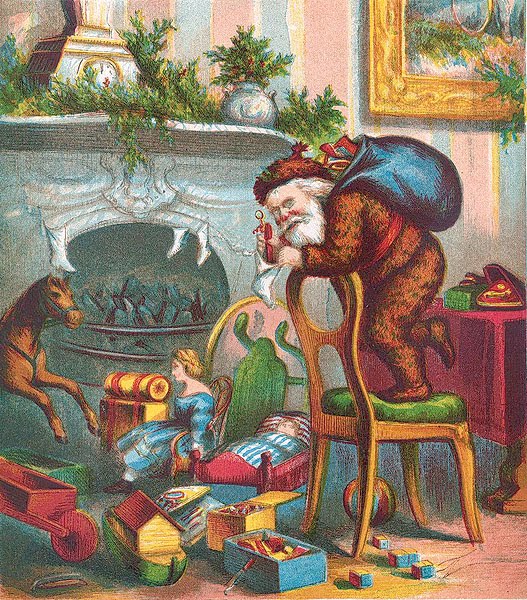 ’Twas the night before Christmas, when all through the house
’Twas the night before Christmas, when all through the house
Not a creature was stirring, not even a mouse.
The stockings were hung by the chimney with care,
In hopes that Saint Nicholas soon would be there.
The children were nestled all snug in their beds,
While visions of sugar-plums danced in their heads;
And mamma in her ’kerchief, and I in my cap,
Had just settled down for a long winter’s nap;
When out on the lawn there arose such a clatter,
I sprang from the bed to see what was the matter.
Away to the window I flew like a flash,
Tore open the shutters and threw up the sash.
The moon on the breast of the new-fallen snow
Gave the lustre of mid-day to objects below,
When, what to my wondering eyes should appear,
But a miniature sleigh, and eight tiny reindeer,
With a little old driver, so lively and quick,
I knew in a moment it must be Saint Nick.
More rapid than eagles his coursers they came,
And he whistled, and shouted, and called them by name:
“Now, Dasher! now, Dancer! now, Prancer and Vixen!
On, Comet! on Cupid! on, Donder and Blitzen!
To the top of the porch! to the top of the wall!
Now dash away! dash away! dash away all!”
As dry leaves that before the wild hurricane fly,
When they meet with an obstacle, mount to the sky,
So up to the house-top the coursers they flew,
With the sleigh full of toys, and Saint Nicholas too.
And then, in a twinkling, I heard on the roof
The prancing and pawing of each little hoof.
As I drew in my head, and was turning around,
Down the chimney Saint Nicholas came with a bound.
He was dressed all in fur, from his head to his foot,
And his clothes were all tarnished with ashes and soot.
A bundle of toys he had flung on his back,
And he looked like a peddler just opening his pack.
His eyes — how they twinkled! his dimples how merry!
His cheeks were like roses, his nose like a cherry!
His droll little mouth was drawn up like a bow,
And the beard of his chin was as white as the snow.
The stump of a pipe he held tight in his teeth,
And the smoke it encircled his head like a wreath.
He had a broad face and a little round belly,
That shook, when he laughed, like a bowlful of jelly.
He was chubby and plump, a right jolly old elf,
And I laughed when I saw him, in spite of myself.
A wink of his eye and a twist of his head,
Soon gave me to know I had nothing to dread.
He spoke not a word, but went straight to his work,
And filled all the stockings; then turned with a jerk,
And laying his finger aside of his nose,
And giving a nod, up the chimney he rose.
He sprang to his sleigh, to his team gave a whistle,
And away they all flew like the down of a thistle.
But I heard him exclaim, ere he drove out of sight,
“Happy Christmas to all, and to all a good-night!”
A Visit from Saint Nicholas – Audio
Here is the audio for a well-known Christmas poem, A Visit from Saint Nicholas. You can practice your listening comprehension. I’ll post the text tomorrow.
Enjoy!
Podcast: Play in new window | Download
Customs: Christmas Gift-Giving at the Office
With the Christmas holidays fast approaching, I thought I would take the opportunity to explain a Christmas custom that might be a little confusing for English learners: the Christmas Gift Exchange.
There are two main ways in which a Christmas gift exchange might be set up:
- Secret Santa
- White Elephant
In a Secret Santa gift exchange, the names of participants are pooled and then drawn out, so each individual has only one person for whom he must buy a gift. The gift giver acts as “Santa” for the recipient, and tries to keep his identity unknown. After the gift has been received and opened, the recipient may try to guess who his “Santa” was. The challenge for the “Santa” lies not only in keeping one’s identity secret, but also in finding out what sort of present the recipient might like without the recipient finding out who “Santa” is.
A Secret Santa might give only one gift, or he might give several small gifts (for example, a small gift every day, or every other day) leading up to the day of the main gift exchange. Often, a monetary limit is set for the gifts, so people don’t feel like they have to spend a lot of money on the gift. If smaller gifts are given, they are usually things like small chocolate bars or other candy, or maybe a fun little toy. The final gift is generally something a little nicer, like a coffee mug or picture frame or something of that type.
Secret Santa gift exchanges tend to be something that women participate in, more so than men.
White Elephant
In a White Elephant gift exchange, the names are pooled as in a Secret Santa exchange. But the main idea of a White Elephant exchange is that the person gives a gift that is usually some sort of a “gag” or joke gift. Thus the emphasis is on a humorous present, and not meant to be serious. (Because of this, I think men are more likely to participate in a White Elephant than in a Secret Santa.)
If you give a White Elephant, you can purchase a funny gift from the store if you want. But usually, a White Elephant is an unwanted or unwelcome gift that you received on a previous occasion – perhaps an ugly vase, or an oversized sweater, or something of that type. In a White Elephant exchange, people expect a gift that is ugly or very unusual, so it is not considered insulting at all to give or receive this type of gift. (And what most people probably do with a White Elephant is store it in a closet and use it for the next year’s White Elephant!). People will laugh and have fun with the silly gifts, and maybe have a little informal contest to see who has the ugliest White Elephant.
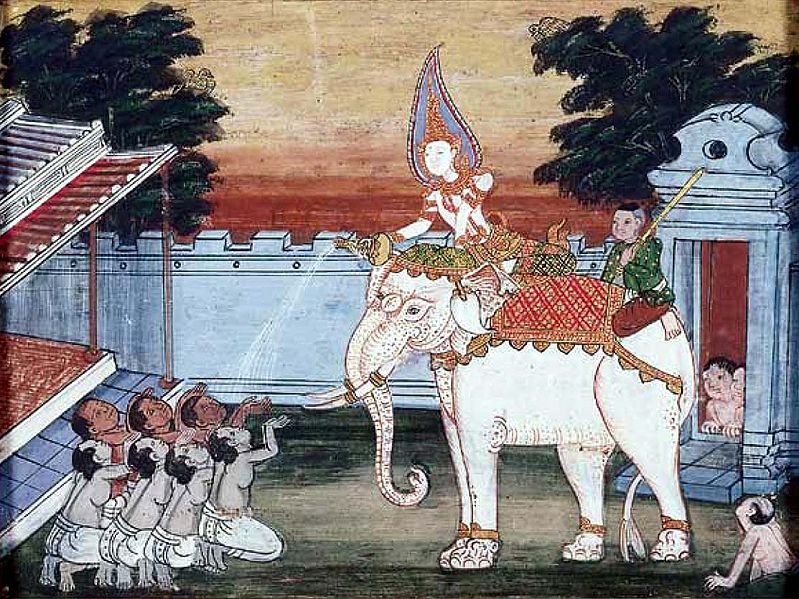 Where does the term “White Elephant” come from? It used to be that in Thailand, a white elephant was considered sacred, and thus it was a sign of favor for the ruler to give someone a white elephant as a gift. However, an elephant is not a very practical gift (they eat so much, and are difficult to take care of, unless you have a zoo), so it was also a gift that turned out to be a burden. Thus the term “White Elephant” came to represent an undesirable or unwelcome gift.
Where does the term “White Elephant” come from? It used to be that in Thailand, a white elephant was considered sacred, and thus it was a sign of favor for the ruler to give someone a white elephant as a gift. However, an elephant is not a very practical gift (they eat so much, and are difficult to take care of, unless you have a zoo), so it was also a gift that turned out to be a burden. Thus the term “White Elephant” came to represent an undesirable or unwelcome gift.
Have you ever gotten a “white elephant”? What was it?

